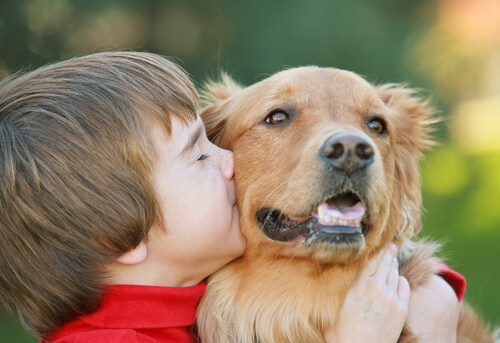Dogs Feel Emotions Comparable to Those of a Child

In recent years, several scientific studies have shown that dogs feel emotions similar to those that a child may feel.
A study from Emory University in Atlanta (United States) showed that dogs feel emotions in the same way as children. The level of sensitivity between one and the other is very similar.
Dogs have the same sensitivity as a child

This is demonstrated by the study carried out by the neurologist Gregory Bens who, after conducting a test with several dogs, including his own, was able to show that canines have the same sensitivity as a child.
The experiment consisted of using several dogs and putting them under an MRI scanner. Throughout the test, the dogs received different types of stimuli, which generated some brain activity.
According to this research, the dogs’ brain activity increased as they received signals that related to food or the smells of familiar people.
Can dogs be optimistic or pessimistic?
On the other hand, a study also related to how dogs feel emotions showed that dogs, like humans, can be optimistic or pessimistic.
That is, when a dog is left alone at home, it becomes distressed and clearly demonstrates it with its barking, destroying things, or relieving itself indoors.
In that sense, the research revealed that canines are anxious when left alone and, with their behavior, tend to be pessimistic.
Professor Mike Mendl is the head of the research group at the University of Bristol (UK) that carried out the study.
In different media, he stated that his team was able to develop a new method to study pessimistic or optimistic decisions in dogs.
The researchers conducted the study with 24 dogs that had recently entered a rehousing shelter in the United Kingdom.
One researcher interacted with each dog in an isolated room for 20 minutes. The next day, the dog was brought back into the room and then left alone for a period of five minutes, during which time its behavior was captured on video.
In those five minutes, the researchers observed that the dog began to bark, jump on the furniture and scratch the door. These behaviors were repetitive in the different animals.
In order to study decision-making in those same dogs, the researchers placed a bowl with food and another that was empty in one place in the room. Both containers were placed in ambiguous places.
Dogs that ran quickly to those ambiguous places, such as waiting for the food reward, were classified as relatively optimistic while those that did not approach the bowl were considered pessimistic.
Mendl said: “We know that people’s emotional states affect their judgments and that happy people are more likely to judge an ambiguous situation positively. Our study has shown that this applies equally to dogs.”
The results suggest that behavior that’s considered problematic for the owners also has an emotional meaning for the animals, even when the behavior itself isn’t being expressed.
In addition, the possibility is raised that some dogs may be more likely to respond with anxiety when left alone.
This is important because separation-related behavior is common in dogs. You can then predict the correct way to treat them, in order for them to enjoy true well-being.
What other things can dogs feel?
Other studies have suggested that dogs can experience negative emotions as humans do, including the equivalent of certain chronic and acute psychological conditions, such as depression.
Similarly, a few years ago, symptoms analogous to clinical depression, neurosis, and other psychological conditions were generally accepted within what has become known as canine emotion.
On the other hand, other research reveals that dogs can also be jealous. This type of behavior, where one animal is frustrated with what is happening to another, has also been observed in primates.
In dogs, according to scientists, this type of behavior is probably due to the close relationship that dogs have with humans. Find out more about it in the article below!
In recent years, several scientific studies have shown that dogs feel emotions similar to those that a child may feel.
A study from Emory University in Atlanta (United States) showed that dogs feel emotions in the same way as children. The level of sensitivity between one and the other is very similar.
Dogs have the same sensitivity as a child

This is demonstrated by the study carried out by the neurologist Gregory Bens who, after conducting a test with several dogs, including his own, was able to show that canines have the same sensitivity as a child.
The experiment consisted of using several dogs and putting them under an MRI scanner. Throughout the test, the dogs received different types of stimuli, which generated some brain activity.
According to this research, the dogs’ brain activity increased as they received signals that related to food or the smells of familiar people.
Can dogs be optimistic or pessimistic?
On the other hand, a study also related to how dogs feel emotions showed that dogs, like humans, can be optimistic or pessimistic.
That is, when a dog is left alone at home, it becomes distressed and clearly demonstrates it with its barking, destroying things, or relieving itself indoors.
In that sense, the research revealed that canines are anxious when left alone and, with their behavior, tend to be pessimistic.
Professor Mike Mendl is the head of the research group at the University of Bristol (UK) that carried out the study.
In different media, he stated that his team was able to develop a new method to study pessimistic or optimistic decisions in dogs.
The researchers conducted the study with 24 dogs that had recently entered a rehousing shelter in the United Kingdom.
One researcher interacted with each dog in an isolated room for 20 minutes. The next day, the dog was brought back into the room and then left alone for a period of five minutes, during which time its behavior was captured on video.
In those five minutes, the researchers observed that the dog began to bark, jump on the furniture and scratch the door. These behaviors were repetitive in the different animals.
In order to study decision-making in those same dogs, the researchers placed a bowl with food and another that was empty in one place in the room. Both containers were placed in ambiguous places.
Dogs that ran quickly to those ambiguous places, such as waiting for the food reward, were classified as relatively optimistic while those that did not approach the bowl were considered pessimistic.
Mendl said: “We know that people’s emotional states affect their judgments and that happy people are more likely to judge an ambiguous situation positively. Our study has shown that this applies equally to dogs.”
The results suggest that behavior that’s considered problematic for the owners also has an emotional meaning for the animals, even when the behavior itself isn’t being expressed.
In addition, the possibility is raised that some dogs may be more likely to respond with anxiety when left alone.
This is important because separation-related behavior is common in dogs. You can then predict the correct way to treat them, in order for them to enjoy true well-being.
What other things can dogs feel?
Other studies have suggested that dogs can experience negative emotions as humans do, including the equivalent of certain chronic and acute psychological conditions, such as depression.
Similarly, a few years ago, symptoms analogous to clinical depression, neurosis, and other psychological conditions were generally accepted within what has become known as canine emotion.
On the other hand, other research reveals that dogs can also be jealous. This type of behavior, where one animal is frustrated with what is happening to another, has also been observed in primates.
In dogs, according to scientists, this type of behavior is probably due to the close relationship that dogs have with humans. Find out more about it in the article below!
All cited sources were thoroughly reviewed by our team to ensure their quality, reliability, currency, and validity. The bibliography of this article was considered reliable and of academic or scientific accuracy.
- Casey, R. A., Naj-Oleari, M., Campbell, S., Mendl, M., & Blackwell, E. J. (2021). Dogs are more pessimistic if their owners use two or more aversive training methods. Scientific Reports, 11(1), 1-8.
- Burman, O., McGowan, R., Mendl, M., Norling, Y., Paul, E., Rehn, T., & Keeling, L. (2011). Using judgement bias to measure positive affective state in dogs. Applied Animal Behaviour Science, 132(3-4), 160-168.
- Jones, S., Neville, V., Higgs, L., Paul, E. S., Dayan, P., Robinson, E. S., & Mendl, M. (2018). Assessing animal affect: an automated and self-initiated judgement bias task based on natural investigative behaviour. Scientific reports, 8(1), 1-12.
- Berns, G. (2017). What It’s Like to be a Dog: And Other Adventures in Animal Neuroscience. Basic Books.
- Berns, G. (2020, March). Decoding the canine mind. In Cerebrum: the Dana Forum on Brain Science (Vol. 2020). Dana Foundation.
- Berns, G. S., Brooks, A. M., & Spivak, M. (2015). Scent of the familiar: An fMRI study of canine brain responses to familiar and unfamiliar human and dog odors. Behavioural processes, 110, 37-46.
This text is provided for informational purposes only and does not replace consultation with a professional. If in doubt, consult your specialist.








